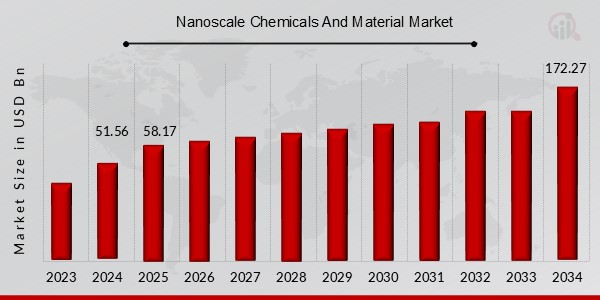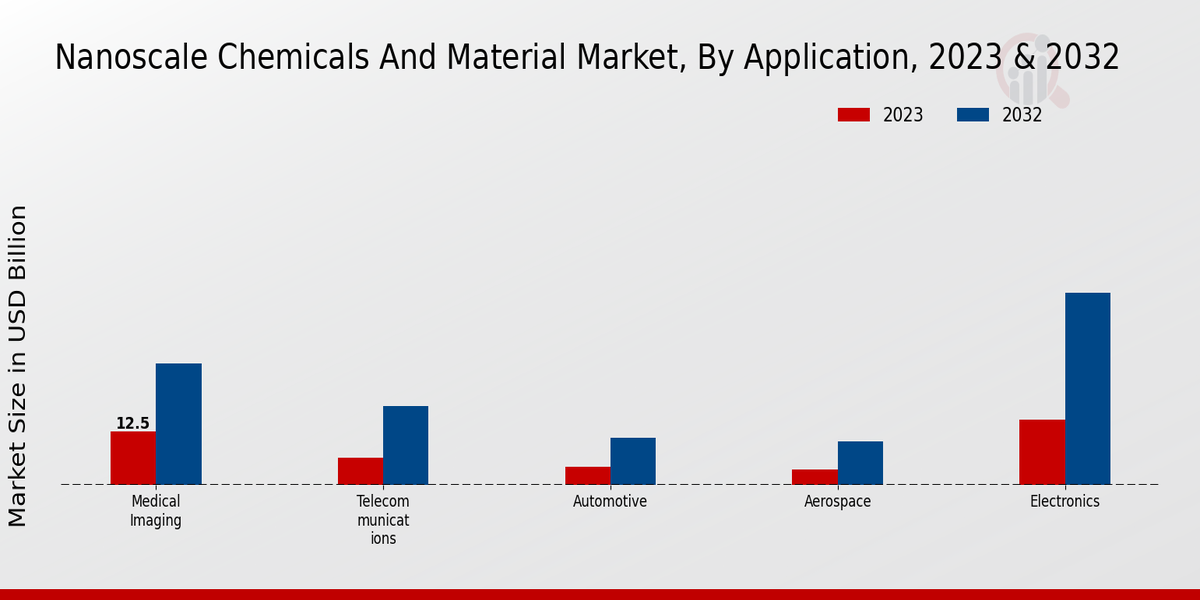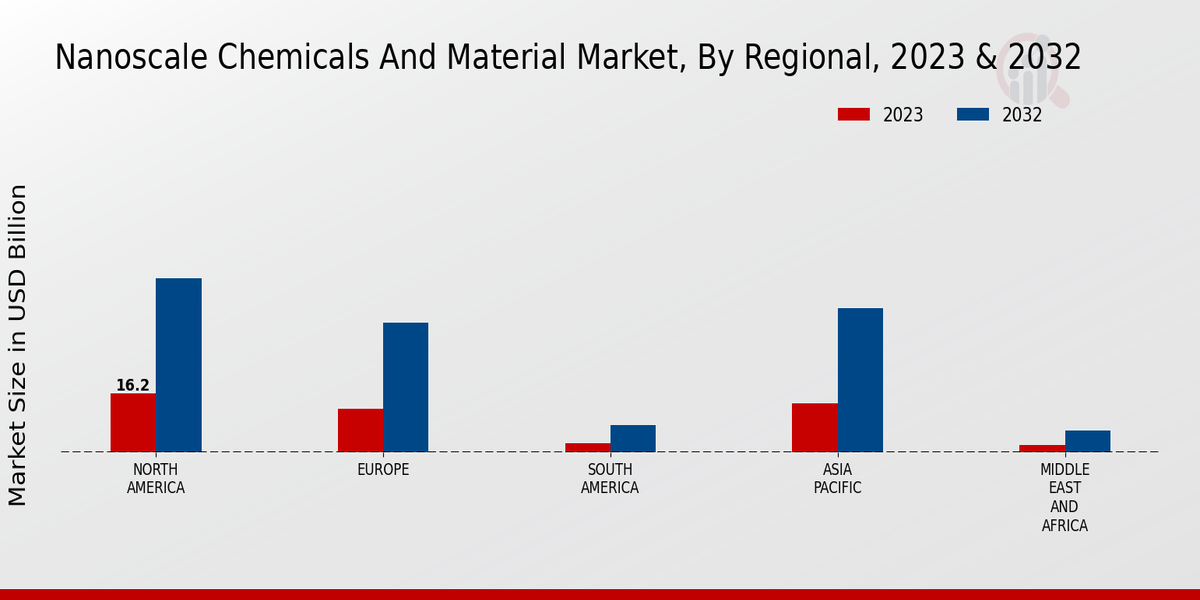Global Nanoscale Chemicals And Material Market Overview
As per MRFR analysis, the Nanoscale Chemicals And Material Market Size was estimated at 51.56 (USD Billion) in 2024. The Nanoscale Chemicals And Material Market Industry is expected to grow from 58.17 (USD Billion) in 2025 to 172.27 (USD Billion) by 2034. The Nanoscale Chemicals And Material Market CAGR (growth rate) is expected to be around 12.82% during the forecast period (2025 - 2034).
Key Nanoscale Chemicals And Material Market Trends Highlighted
The nanoscale chemicals and materials market is experiencing a surge in demand, driven by advancements in various industries such as electronics, aerospace, healthcare, and energy. Key market drivers include the increasing demand for high-performance materials with enhanced properties, such as strength, durability, and conductivity. The integration of nanoscale materials into electronic devices enables miniaturization, faster processing speeds, and improved energy efficiency. Additionally, the growing focus on renewable energy sources, such as solar and fuel cells, is fueling the demand for nanoscale materials for efficient energy storage and conversion.
Recent trends in the nanoscale chemicals and materials market include the emergence of nanomaterials with tailored properties, such as self-cleaning surfaces, antimicrobial coatings, and lightweight composites. The use of artificial intelligence (AI) and machine learning (ML) is accelerating the development and optimization of nanoscale materials, leading to improved performance and cost-effectiveness. Moreover, the increasing adoption of nanomaterials in biomedical applications, such as drug delivery systems and diagnostics, is creating new opportunities for growth in the healthcare sector.

Source Primary Research, Secondary Research, MRFR Database and Analyst Review
Nanoscale Chemicals And Material Market Drivers
Demand for Improved Performance and Efficiency across Industries
The escalating demand for enhanced performance and efficiency across a wide range of industries, including electronics, automotive, healthcare, and aerospace, is propelling the growth of the Nanoscale Chemicals And Material Market Industry. Nanoscale chemicals and materials offer unique properties, such as high strength, lightweight, and enhanced electrical and thermal conductivity, making them ideal for applications where traditional materials fall short.
For instance, in the electronics industry, nanoscale materials are being incorporated into semiconductors and other components to improve device performance and reduce energy consumption. Similarly, in the automotive sector, nanoscale chemicals are utilized to develop lightweight and fuel-efficient vehicles. As industries continue to strive for innovation and optimization, the demand for nanoscale chemicals and materials is expected to remain strong.
Government Funding and Support for Nanotechnology Research
Governments worldwide recognize the transformative potential of nanotechnology and are actively supporting research and development initiatives in this field. Funding from government agencies plays a crucial role in advancing nanoscale chemistry and materials science. This support enables researchers to explore new frontiers, develop innovative materials, and refine existing technologies. Moreover, government incentives, such as tax breaks and grants, encourage private-sector investment in nanotechnology research. The sustained government commitment to nanotechnology is anticipated to drive significant advancements in the Nanoscale Chemicals And Material Market Industry.
Growing Focus on Sustainability and Environmental Concerns
The increasing emphasis on sustainability and environmental consciousness is positively impacting the Nanoscale Chemicals And Material Market Industry. Nanoscale materials offer unique opportunities to address environmental challenges. For example, nanoscale catalysts can enhance the efficiency of energy conversion and storage systems, contributing to a cleaner and more sustainable energy landscape. Additionally, nanoscale materials can be engineered to possess antimicrobial properties, reducing the need for harmful chemical additives in various products. As consumers and businesses become more environmentally conscious, the demand for sustainable nanoscale chemicals and materials is expected to surge.
Nanoscale Chemicals And Material Market Segment Insights
Nanoscale Chemicals And Material Market Application Insights
The Nanoscale Chemicals And Material Market is segmented into various applications, including medical imaging, telecommunications, automotive, aerospace, and electronics. Each segment offers unique growth opportunities and challenges. Medical Imaging Nanoscale chemicals and materials play a crucial role in medical imaging, particularly in the development of contrast agents for enhancing the visibility of specific tissues and organs during imaging procedures. The growing demand for advanced medical imaging techniques, such as magnetic resonance imaging (MRI) and computed tomography (CT) scans, is driving the growth of this segment.
The market for nanoscale chemicals and materials in medical imaging is expected to reach USD 12.5 billion by 2025, expanding at a CAGR of 9.8% from 2020 to 2025. Telecommunications Nanoscale chemicals and materials are essential for the development of high-performance telecommunication devices and infrastructure. They are used in the production of advanced materials for antennas, filters, and other components that enable faster data transmission and improved signal quality. The increasing demand for bandwidth-intensive applications, such as video streaming and cloud computing, is fueling the growth of this segment.
The market for nanoscale chemicals and materials in telecommunications is projected to grow to USD 6.8 billion by 2025, with a CAGR of 11.2% from 2024 to 2032. Automotive Nanoscale chemicals and materials are finding applications in various areas of the automotive industry, including lightweight materials, energy storage systems, and sensors. The use of these materials can improve fuel efficiency, reduce emissions, and enhance vehicle safety. The growing adoption of electric vehicles and the increasing demand for sustainable transportation solutions are driving the growth of this segment.The market for nanoscale chemicals and materials in the automotive industry is anticipated to reach USD 4.2 billion by 2032, expanding at a CAGR of 10.5% from 2024 to 2032. Aerospace Nanoscale chemicals and materials are used in aerospace applications to enhance the performance and safety of aircraft and spacecraft. They are employed in the development of lightweight and durable materials, improved coatings for corrosion resistance, and advanced sensors for enhanced navigation and control. The increasing demand for fuel-efficient and environmentally friendly aircraft is driving the growth of this segment.The market for nanoscale chemicals and materials in the aerospace industry is projected to grow to USD 3.6 billion by 2032, with a CAGR of 10.2% from 2024 to 2032. Electronics Nanoscale chemicals and materials are essential for the miniaturization and performance enhancement of electronic devices. They are used in the production of semiconductors, transistors, and other components that enable faster processing speeds, lower power consumption, and improved functionality. The growing demand for smartphones, laptops, and other portable devices is fueling the growth of this segment. The market for nanoscale chemicals and materials in the electronics industry is expected to reach USD 15.3 billion by 2032, expanding at a CAGR of 10.9% from 2024 to 2032.

Source Primary Research, Secondary Research, MRFR Database and Analyst Review
Nanoscale Chemicals And Material Market Material Type Insights
The Material Type segment of the Nanoscale Chemicals And Material Market is anticipated to showcase substantial growth in the coming years. Metal Nanoparticles, with a market valuation of 12.2 billion USD in 2023 and a projected CAGR of 13.1%, is poised to dominate the segment. Ceramic Nanoparticles, exhibiting a promising growth trajectory, are estimated to reach a market size of 6.3 billion USD by 2032. Polymer Nanoparticles, characterized by their versatility and wide range of applications, are anticipated to witness steady growth, capturing a significant market share.
Carbon Nanomaterials, encompassing carbon nanotubes and graphene, are expected to exhibit robust growth due to their unique properties and increasing adoption in various industries. Quantum Dots, known for their exceptional optical properties, are projected to witness a notable market expansion, driven by their growing use in display technologies and biomedical applications.
Nanoscale Chemicals And Material Market Synthesis Method Insights
The Nanoscale Chemicals And Material Market is segmented by Synthesis Method into Chemical Vapor Deposition (CVD), Physical Vapor Deposition (PVD), Molecular Beam Epitaxy (MBE), Solution-Phase Synthesis, and Template-Assisted Synthesis. The Chemical Vapor Deposition (CVD) segment held the largest market share in 2023, accounting for over 30% of the Nanoscale Chemicals And Material Market revenue. This is due to the high adoption of CVD in the semiconductor industry for the production of thin films and nanostructures. The Solution-Phase Synthesis segment is expected to grow at the highest CAGR during the forecast period, owing to the increasing demand for nanoscale materials in various applications such as energy storage, catalysis, and biomedical devices.
Nanoscale Chemicals And Material Market Size Insights
The Nanoscale Chemicals And Material Market is segmented by size into 1-10 nm, 10-100 nm, and 100-1000 nm. The 100-1000 nm segment is expected to grow at a CAGR of 12.82% from 2024 to 2032, reaching a value of USD 17.5 billion by 2032. The growth of the nanoscale chemicals and materials market is being driven by the increasing demand for these materials in various applications, such as electronics, healthcare, and energy.
Nanoscale Chemicals And Material Market End User Insights
The end-user segment of the Nanoscale Chemicals And Material Market is expected to grow significantly in the coming years. This growth can be attributed to the increasing demand for nanoscale chemicals and materials in various end-use industries, including research institutes, pharmaceutical companies, electronic manufacturers, automotive companies, and aerospace companies. Research institutes are investing heavily in nanoscale chemicals and materials to develop new and innovative products. Pharmaceutical companies are using nanoscale materials to develop targeted drug delivery systems and improve drug efficacy.
Electronic manufacturers are using nanoscale materials to create smaller and more efficient devices. Automotive companies are using nanoscale materials to develop lighter and stronger vehicles. Aerospace companies are using nanoscale materials to develop more durable and heat-resistant materials for aircraft. The growth of the End User segment is also being driven by the increasing demand for nanoscale chemicals and materials in emerging economies. China, India, and Brazil are expected to be major growth markets for nanoscale chemicals and materials in the coming years. The increasing demand for nanoscale chemicals and materials in these countries is being driven by the rapidly growing manufacturing and automotive industries.
Nanoscale Chemicals And Material Market Regional Insights
The regional landscape of the Nanoscale Chemicals And Material Market exhibits significant variations in market growth, driven by factors such as economic development, technological advancements, and regulatory frameworks. North America dominates the market, accounting for over 40% of the Nanoscale Chemicals And Material Market revenue in 2023. The region's robust infrastructure, advanced research capabilities, and favorable regulatory environment contribute to its leading position. Europe follows closely, with a market share of around 30%.
The region's strong manufacturing base, coupled with initiatives to promote sustainable technologies, fuels its market growth. APAC is projected to witness the highest growth rate during the forecast period, primarily driven by the rapidly expanding economies of China and India. Government investments in nanotechnology research and development are also driving market expansion in the region. South America and MEA hold relatively smaller market shares but present significant growth opportunities due to increasing industrialization and urbanization.

Source Primary Research, Secondary Research, MRFR Database and Analyst Review
Nanoscale Chemicals And Material Market Key Players And Competitive Insights
Major players in the Nanoscale Chemicals And Material Market industry, such as Nanoscale Chemicals And Material Market, are constantly striving to gain a competitive edge by developing innovative products, expanding their distribution networks, and acquiring smaller companies. The Nanoscale Chemicals And Material Market development is expected to be driven by the increasing demand for advanced materials in various industries, including electronics, healthcare, and energy. The Nanoscale Chemicals And Material Market Competitive Landscape is expected to remain fragmented over the forecast period, with a number of key players competing for market share.Leading Nanoscale Chemicals And Material Market players such as BASF SE are focusing on expanding their reach and investing in research and development to maintain their competitive position. The company offers a wide range of nanoscale chemicals and materials, including carbon nanotubes, graphene, and metal oxides. BASF SE is also involved in partnerships with other companies to develop and commercialize new nanoscale products.A competitor company to BASF SE in the Nanoscale Chemicals And Material Market industry is Cabot Corporation. The company offers a range of nanoscale chemicals and materials, including carbon black, fumed silica, and activated carbon. Cabot Corporation is focused on expanding its reach and investing in research and development to maintain its competitive position. The company has a strong presence in the automotive, electronics, and construction industries.
Key Companies in the Nanoscale Chemicals And Material Market Include
- Albemarle Corporation
- Solvay
- Dow
- Henkel
- Momentive Performance Materials Inc.
- DuPont
- Evonik Industries
- Eastman Chemical Company
- 3M
- Huntsman Corporation
- Merck KGaA
- Wacker Chemie AG
- Cabot Corporation
- Nanomaterials International
- BASF
Nanoscale Chemicals And Material Market Industry Developments
Increasing demand for lightweight, durable, and high-performance materials in various industries, such as automotive, aerospace, and electronics, is driving market growth. Government initiatives and funding for nanotechnology research and development are further propelling market expansion.Recent news developments in the market include the development of self-cleaning and antibacterial surfaces using nanoscale materials, the integration of nanomaterials in wearable devices for healthcare monitoring, and the emergence of nanocatalysts for efficient chemical reactions. Key players in the market are focusing on strategic partnerships, mergers, and acquisitions to expand their product offerings and geographic reach.
Nanoscale Chemicals And Material Market Segmentation Insights
Nanoscale Chemicals And Material Market Application Outlook
Medical Imaging
Telecommunications
Automotive
Aerospace
Electronics
Nanoscale Chemicals And Material Market Material Type Outlook
Metal Nanoparticles
Ceramic Nanoparticles
Polymer Nanoparticles
Carbon Nanomaterials
Quantum Dots
Nanoscale Chemicals And Material Market Synthesis Method Outlook
Chemical Vapor Deposition (CVD)
Physical Vapor Deposition (PVD)
Molecular Beam Epitaxy (MBE)
Solution-Phase Synthesis
Template-Assisted Synthesis
Nanoscale Chemicals And Material Market Size Outlook
1-10 nm
10-100 nm
100-1000 nm
Nanoscale Chemicals And Material Market End User Outlook
Research Institutes
Pharmaceutical Companies
Electronic Manufacturers
Automotive Companies
Aerospace Companies
Nanoscale Chemicals And Material Market Regional Outlook
North America
Europe
South America
Asia Pacific
Middle East and Africa
| Report Attribute/Metric |
Details |
| Market Size 2024 |
51.56 (USD Billion) |
| Market Size 2025 |
58.17 (USD Billion) |
| Market Size 2034 |
172.27 (USD Billion) |
| Compound Annual Growth Rate (CAGR) |
12.82% (2024 - 2032) |
| Report Coverage |
Revenue Forecast, Competitive Landscape, Growth Factors, and Trends |
| Base Year |
2024 |
| Market Forecast Period |
2025 - 2034 |
| Historical Data |
2020 - 2024 |
| Market Forecast Units |
USD Billion |
| Key Companies Profiled |
Albemarle Corporation, Solvay, Dow, Henkel, Momentive Performance Materials Inc., DuPont, Evonik Industries, Eastman Chemical Company, 3M, Huntsman Corporation, Merck KGaA, Wacker Chemie AG, Cabot Corporation, Nanomaterials International, BASF |
| Segments Covered |
Application, Material Type, Synthesis Method, Size, End User, Regional |
| Key Market Opportunities |
Advanced drug delivery systems High performance coatings Energy storage devices Electronics applications Biomedical imaging |
| Key Market Dynamics |
Growth driversAdvancements in nanoscale technologyRising applications in various industriesGovernment funding and investments |
| Countries Covered |
North America, Europe, APAC, South America, MEA |
Frequently Asked Questions (FAQ) :
The nanoscale chemicals and materials market is projected to grow at a CAGR of 12.82% from 2025 - 2034.
The nanoscale chemicals and materials market is expected to reach an overall valuation of USD 172.27 billion by 2034.
Asia-Pacific is expected to hold the largest market share in the nanoscale chemicals and materials market by 2034.
Nanoscale chemicals and materials are used in a wide range of applications, including electronics, energy, healthcare, and manufacturing.
Some of the key competitors in the nanoscale chemicals and materials market include BASF, Dow, Evonik, and Merck.
The major factors driving the growth of the nanoscale chemicals and materials market include increasing demand for nanotechnology-based products, growing investment in research and development, and government support for nanotechnology initiatives.
Some of the challenges facing the nanoscale chemicals and materials market include regulatory concerns, safety issues, and the need for specialized manufacturing processes.
Some of the key trends expected to shape the future of the nanoscale chemicals and materials market include the development of new nanomaterials, advances in nanomanufacturing, and the growing integration of nanotechnology with other fields.
The nanoscale chemicals and materials market is expected to be valued at USD 51.56 billion in 2024.
The nanoscale chemicals and materials market is projected to reach a valuation of USD 172.27 billion by 2032.
















